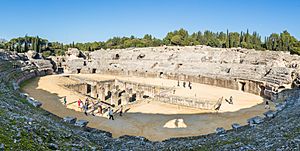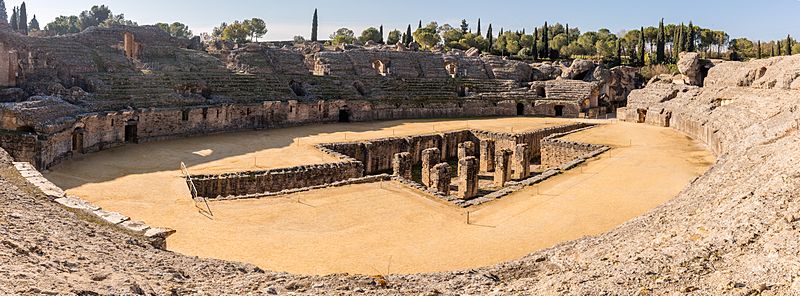Roman amphitheatre of Italica facts for kids

View of the Roman amphitheatre of Italica.
|
|
| Location | Santiponce, in Andalusia, Spain. |
|---|---|
| Coordinates | 37°26′38″N 6°02′48″W / 37.44389°N 6.04667°W |
| Type | Roman amphitheatre |
| History | |
| Founded | AD 117 and 138 |
| Periods | Roman Empire |
The Roman amphitheatre of Italica (Spanish: Anfiteatro romano de Itálica) is a ruined Roman amphitheatre situated outside the ancient Roman settlement of Italica, around 300 metres from the city's northern entrance. The amphitheatre's location is in present-day Santiponce, Andalusia, Spain, close to the city of Seville.
It was built during the reign of emperor Hadrian (who was born in Italica), approximately between the years AD 117 and 138, and was one of the largest in the entire Roman Empire. Italica was largely abandoned by the Romans in the 3rd century. It was rediscovered during the Renaissance, in the 17th century, and work to unearth the amphitheatre began in the late 19th century. The amphitheatre is now a tourist site offering visitor tours.
Architectural features
The amphitheatre had capacity of 25,000 spectators. It has an elliptical shape, with a major axis of 160 metres (525 ft) and minor axis of 137 metres (449 ft), it had three levels of stands, of which the first remains intact, the second partially so, and the third mostly in ruin. Under the level of the old wooden floor of the amphitheater there was a service pit for the different gladiatorial shows and fights against wild beasts, called venatio. The building was constructed using siliceous and calcareous pebbles, as a result of a shortage of natural stone in the region.
The amphitheatre's cavea was divided into three sections, the ima, media and summa cavea, separated by annular corridors called praecinctions. The first, the ima cavea, had 6 stands, with 8 access doors, and was reserved for a ruling class. The second, the media cavea, was intended for the humblest population, had 12 tiers and 14 access doors. The summa cavea, covered by an awning, was reserved only to children and women.
The amphitheatre also had several rooms dedicated to the cult of Nemesis and Juno.
Gallery
See also
 In Spanish: Anfiteatro de Itálica para niños
In Spanish: Anfiteatro de Itálica para niños
- List of Roman amphitheatres
- List of Roman sites in Spain



